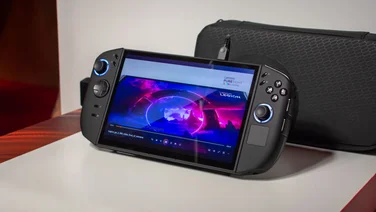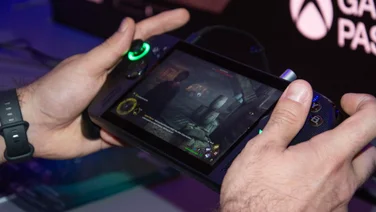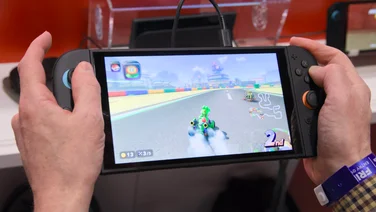To help us provide you with free impartial advice, we may earn a commission if you buy through links on our site. Learn more
- PlayStation 5 review: What you need to know
- PlayStation 5 review: Price and competition
- PlayStation 5 review: Design and key features
- PlayStation 5 review: DualSense controller
- PlayStation 5 review: User interface
- PlayStation 5 review: Performance
- PlayStation 5 review: Games and services
- PlayStation 5 review: Verdict











- Gorgeous new user interface
- DualSense is astonishing
- Strong launch library
- Games run well
- Not enough storage
- This console is HUGE
- Series X is more powerful
The PlayStation 5 is a difficult thing to review. Not because it’s technically demanding, nor indeed because it’s in any way underwhelming, but because the sweeping majority of consumers have already decided that they want one. Gamesindustry.biz ran a survey soon after preorders opened and found that around 80% of those asked were opting for Sony’s new console over the Xbox Series X. With stats like these, who needs opinions?
Don’t get me wrong, I’m not here to swim against the current. The PS5 is every bit as impressive as you’d expect and I’d urge any self-respecting PlayStation fan to go out and nab one immediately – if you haven’t already. But with so many people ready to stake a fair amount of cash on the PlayStation 5, I think it’s worth properly scrutinising the machine that appears to have won the console war before it even started.
READ NEXT: Here’s where to preorder the PS5
PlayStation 5 review: What you need to know
Before I begin, however, some key information. The PS5 is to the PS4 what the PS4 was to the PS3. It represents a substantial improvement on a technical level in just about every way: from the user interface to the hardware, this is a total overhaul.











The new AMD-made processors can run games in 4K at up to 120 frames per second (or at least a stable 30), while the custom SSD storage drive reduces load times and speeds up navigation of the new user interface significantly.
In terms of specifics, the PS5 houses an 825GB NVMe SSD, paired with 16GB of GDDR6 RAM, an octa-core AMD Zen 2-based CPU clocked at 3.5GHz and an AMD RDNA 2-based GPU. Sony promises a total 10.28 teraFLOPS of power: that’s a huge amount more than the PS4 Pro’s 4.2 teraFLOPS, and an extraordinary upgrade over the original PS4’s meagre 1.84 teraFLOPS.
READ NEXT: See how the PS5 compares to the Xbox Series X in our head-to-head
PlayStation 5 review: Price and competition
All that power will make a sizable dent in your bank balance. The standard PS5 launched at £450 in the UK, with the digital edition – sans optical drive – coming in at £90 less. After a price increase in August 2022, however, the PS5 will now cost you £480, with the discless model coming it at £390. That’s a lot of money, especially after the £30 price bump, but it really shouldn’t be that big a consideration. After all, this is a console that will see you through several years of gaming.
Incidentally, this is the exact same price as the PS5’s only real rival in the console space: the Xbox Series X. Boasting a total 12 teraFLOPS of compute power, the Series X is the more powerful console, although obviously power is not the sole measure of a console’s success. The Series X also has a smaller, cheaper sibling, the Xbox Series S, which is available for £250 – this tiny console won’t run games at 4K but it will do high frame rates and effortlessly fast loading times.











If it’s a Sony console you’re after, the PS5’s primary competition comes from the PS4 Pro, which traditionally costs £350 (although short supply is raising the prices to £400 and more). With the standard PS4 Slim hovering at around the £270 mark, however, now is a good time to nab the last-gen console on the cheap, if funds are tight and 4K doesn’t appeal.
PlayStation 5 review: Design and key features
Let’s start with the rather literal elephant in the room. The PS5 is enormous. At roughly 39cm from top to bottom when upright, the PS5 is probably the largest games console ever made, and almost certainly the heaviest. This isn’t a huge issue, but it does mean you won’t be able to keep the console somewhere discreet – not that Sony wants you to.
No, Sony chucked discretion out of the window when it chose the PS5’s white finish, sweeping curves and up-turned “collar”. That collar serves a dual purpose: both to channel air towards the fans and act as a reflective panel for the status indicator lights, making it easier to see them from an angle. Let’s be honest, it isn’t the most attractive thing you’ve ever seen, although it certainly is imposing when standing upright. You can also lay the PS5 flat if you prefer – just be aware that you’ll need a screwdriver to do it. Sony is introducing a new digital edition of the console that doesn’t require any tools to shift from horizontal to vertical orientation.
Lining the front and rear of the PS5’s black “interior” is a selection of ports and buttons. The front panel houses the power and disc eject button plus a single USB 2 port and – interestingly – a USB Type-C port (10Gbit/sec). On the rear, there’s an HDMI 2.1 port, a figure-eight power lead port, two USB 3.1 Gen 1 ports (10Gbit/sec) and a Gigabit Ethernet port. An optical disc drive is hidden beneath one of the two white exterior panels. You get the idea.











UPDATE: There are two features that the PS5 lacked at launch. Both synergise nicely with the latest 4K gaming TVs: Auto Low Latency Mode (ALLM) automatically switches the connected display into its lowest latency mode (usually “game” mode), while Variable Refresh Rate (VRR) enables console and display to synchronise frame rate and refresh rate, thereby preventing annoying screen tearing and artifacts. After a couple of firmware updates in the summer of 2022, the PS5 now comfortably supports both of these features. You can find controls for both in your system settings.
PlayStation 5 review: DualSense controller
Paradoxically, the console itself is the least exciting aspect of the PS5; instead, it’s the new DualSense controller that steals the show. Where Microsoft was content with marginal improvements, Sony has pushed the boat out, creating in the process the best game controller I’ve ever used.
The DualSense controller is slightly larger and heavier than its predecessor and is partially textured to reduce the impact of sweaty palms. As a result, it’s supremely comfortable to hold; I felt my hand was less prone to cramping since it wasn’t wrapped so tightly around the grips.











It’s not just about the look and feel, though; Sony’s new gamepad is bristling with technology. There’s a built-in microphone, so obnoxious teens can hurl insults at you (and you at them) in pre-game lobbies with minimal hassle. Directly above the mic sits a large, LED-lit mute button, which is a thoughtful touch no doubt intended to allay any privacy concerns; and below the mic, a 3.5mm headphone jack, for the traditionalists out there.
Then there’s the speaker, which no longer sounds half as tinny. And the rumble motors, which are advanced enough that they can now emulate the feeling of walking on different terrains. And, of course, the fact that the DualSense now charges from empty in around one hour via USB Type-C – and runs for much, much longer on a single charge than its predecessor.











The cherries on the cake, however, are the rear bumpers and triggers. Aside from being much larger, the triggers (L2 and R2) can now adjust their own resistance levels on the fly, meaning game developers can vary trigger strength by weapon, or implement resistance when using the throttle in racing simulators. I’m incredibly excited to see where next-gen games on PS5 take this particular feature.
READ NEXT: The best 4K TVs for next-gen gaming
PlayStation 5 review: User interface
Pressing the PlayStation button on the DualSense controller switches the PS5 on and brings me neatly to the next point of discussion: the user interface. Like the controller, the new UI is more than just an iterative update; Aside from a much-needed coat of paint, the PS5 home menu also has a few tricks up its sleeve.
Die-hard PlayStation fans will be relieved to hear that navigating the menus hasn’t changed all that much. Installed games are still presented on a row of tiles, but this row – the immortal Cross Menu Bar – sits more discreetly at the top of the screen. Where on the PS4 they felt like a clunky afterthought, your game trophies and media now take the limelight. These sit in the new Game Hub, a game-specific menu from which you can also launch directly into your last save file, skipping opening credits and main menus in the process.

Sony has combined the remaining PS4 menu elements into a single tool called the Control Bar. This contains all the crucial information, from online friends to current downloads to power options. It’s totally customisable: you can add network, broadcasting and even accessibility options, and remove existing items.
The Control Bar also includes the new Game Switcher. This allows you to hop between recent titles or close your current game from a single menu. Using this feature while playing Horizon Zero Dawn, I was able to hop almost instantly into my most recent Spider-Man: Miles Morales save file. It’s nothing like as impressive as the Quick Resume function of the Xbox Series X – the original game will close – but it’s still a good demonstration of just how rapid the new SSD is.
To put it simply: the PS4 user interface was a product of several major updates that sat somewhat haphazardly on top of one another. The PS5 UI takes these strands and ties them together in a far more attractive, cohesive and intuitive package.
PlayStation 5 review: Performance
Of course, intuition isn’t worth a jot if the PS5 can’t walk the walk. Fortunately, gaming on the PS5 is exactly as mind-blowing as you’d expect it to be, especially if you’ve spent the past six years on an increasingly exhausted PlayStation 4. For the vast majority of PS4 gamers, the upgrade in visual quality and animation “smoothness” that comes at high resolutions and high frame rates will be immediately noticeable.
The PS5 supports ray tracing, which means that anything you see in-game relating to lighting – be that shadows or reflections – will be much, much more true-to-life. This is something that can be demonstrated quite easily using the comparison screenshots of Spider-Man: Miles Morales below.

[Shots taken in Performance mode (top) and Fidelity mode (bottom). Notice the reflection in the window – it’s far more realistic when ray tracing is on.]
Then there’s that SSD storage, which facilitates extraordinarily fast loading times and should in the long run make for larger, more complex open-world games. Red Dead Redemption 2 loads in a leisurely two minutes and 20 seconds from the PS4’s home screen; on PS5, that figure is cut almost in half. Spider-Man: Miles Morales, meanwhile, can load in around ten seconds, and does away with in-game loading screens altogether.
Sony has also made huge improvements to the PS5’s cooling system and, as a result, the console is eerily quiet. I attempted to elicit some noise by booting up God of War, a game that infamously turns most PS4 and PS4 Pro consoles into jet engines, but had no luck. The PS5 made so little noise I couldn’t even measure it above the background hum of my flat. This is a huge deal to me, as I have put off playing games like God of War in the past due to the unbearable fan whine.
In spite of these impressive achievements, however, the PS5 simply cannot match the Xbox Series X for pure performance. Where the Series X targets “native” 4K and 60 frames per second for pretty much every game it runs, the PS5 is a little more complex.
The new Spider-Man, for example, offers two graphics settings: “Fidelity” mode runs the game at native 4K with ray tracing enabled, but caps the frame rate at 30fps; “Performance” mode leverages a technique called checkerboarding to produce an artificial 4K resolution, whilst also ditching ray tracing and upping the frame rate cap to 60fps.
Sony clearly anticipates a lot of these sorts of compromises, since the PS5 has a cluster of settings relating to how you’d prefer to launch your games – prioritising resolution, frame rate or the developer preset.











It’s ultimately a minor niggle, as games still look great and run exceptionally well. Checkerboarding is furthermore an incredibly impressive bit of technical trickery and you’ll have to get within millimetres of your TV to notice any difference from native 4K. And as I’ve already said, the pure visual upgrade over games on the standard PS4 is so vast you’ll soon forget any nitpicking.
There is one irreconcilable issue, though, and that’s the amount of storage you get for the money. As games creep up toward the 200GB mark that measly 825GB drive (closer to 600GB when you exclude system files) is simply not going to be enough.
UPDATE: As of PS5 firmware update 21.02-04, you can expand that 825GB of storage using a second standard-sized M.2 NVMe SSD by gently popping off the front panel. Unlike external storage, any compatible M.2 SSD you install will be able to store and play PS5 games – although the console will warn you once the SSD is installed if you’re likely to notice slower load times versus the built-in storage. Mark Cerny recommends the WD_Black SN850 as it comfortably exceeds the 5.5GB/sec minimum speeds suggested by Sony.
It’s important that you purchase an NVMe with a heatsink, as these storage devices warm up fast and the console has no cooling system in place for additional SSDs.











I should also point out that initially, the PS5 supported 1080p and 2160p resolutions with nothing in-between, while the Xbox Series X and S could both run games at the happy medium of 1440p. After a firmware update in September 2022, however, the PS5 can now run most games at 1440p, whether they support it natively or not. You can find 1440p controls in your system settings.
PlayStation 5 review: Games and services
If it wasn’t already abundantly clear, so far I have been playing PS4 games on the PS5. Thankfully, the overwhelming majority of PS4 games will run on the new console. You also have the option to import saves from an existing PS4, either via a cable or via PS Plus cloud storage, which is a bit of a relief. You can even use a PS4 controller to navigate the UI and play PS4 games on PS5.
The issue with Sony’s backwards compatibility claim is that it involves no built-in optimisation. The Xbox Series X will upgrade graphical quality of old titles where it can, but the PlayStation will simply reduce its performance to match the console the game was most recently optimised for – be that PS4 or PS4 Pro. Unofficially, however, I did notice that some PS4 games performed better on PS5: Monster Hunter World, for example, was clearly running at 4K at a higher frame rate than it does on the PS4 Pro.
So backwards compatibility is a little lacking but at least players can play their favourite PS4 games while they wait for PS5 games to start rolling in. Not that they’ll have to wait long: exclusive launch titles for the PS5 include Spider-Man: Miles Morales, Demon’s Souls and Sackboy: A Big Adventure, with games like FIFA 21, Watch Dogs: Legion and Assassin’s Creed Valhalla also available on both next-gen systems. It’s a great lineup, and it comes bolstered by the PlayStation Plus Collection, a bundle of 20 exclusive and non-exclusive PS4 games that’s free for PS Plus members.
Speaking of whom: if you are a PS Plus subscriber, you can benefit from the usual slew of discounts and free monthly games alongside cloud storage and other added functionality. The PS5 also offers a unique game helper for PS Plus members, accessed via the Game Hub; this helper currently works with next-gen PS5 exclusives and drops hints when you’re stuck on a level. It’s not exactly a mind-blowing feature but it may save you opening YouTube on your phone when you get stuck.
PlayStation 5 review: Verdict
The anticipation surrounding Sony’s next-gen console is so great that my impressions of the machine itself will always be drowned out a bit. It’s fortunate, then, that the PS5 is Sony’s best console to date. Effortlessly fast and unexpectedly innovative, the PS5 is more than capable of shouldering the burden of expectation it has been handed by those who have preordered it in their droves.
Sure, it’s let down a little by a few niggling flaws that might make the fussiest of you consider purchasing the uber-powerful Xbox Series X instead. To the vast majority of console gamers, however, the PS5 will utterly blitz past any expectations or preconceptions. It really is that good.







